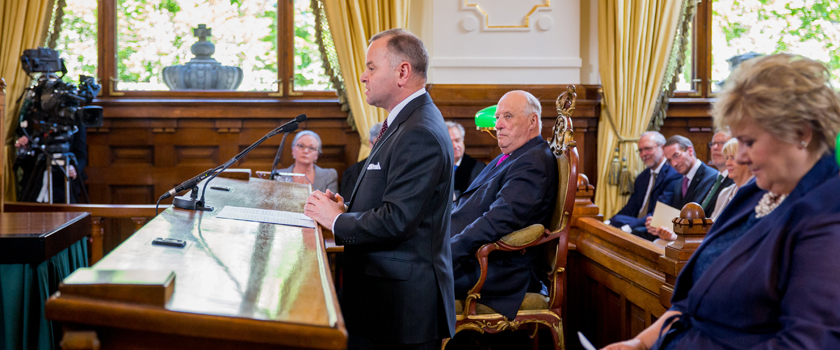
President of the Storting Olemic Thommessen making a speech to mark the bicentenary of the Supreme Court. Photo: Morten Brakestad / The Supreme Court of Norway.
200 years of the Supreme Court of Norway
The Supreme Court of Norway celebrated its bicentenary on Tuesday 30th June. The President of the Storting made a speech during the ceremony.
On 30th June 1815, the Supreme Court held its very first sitting and pronounced its very first judgement. Two centuries on, the King, the President of the Storting and the Prime Minister were among those present to mark its bicentenary. The Storting is also celebrating the anniversary with its own Court of Impeachment exhibition.
Independent – unimpeachable – far-sighted
“The Supreme Court has a reputation for being independent, unimpeachable and far-sighted. It’s impossible to overstate how important these qualities are for Norwegian democracy. Throughout its 200-year existence, our highest court has deservedly gained the almost unlimited confidence of the people,” says President of the Storting Olemic Thommessen.
“The guarantor of a society based on trust is a judicial system that – independently and by virtue of its own professional legitimacy – stands tall when others crumble. When, on behalf of the Storting, I congratulate the Supreme Court on its 200th anniversary, it’s in the firm belief that the Supreme Court will continue to deserve the unconditional trust and confidence of the people,” he said.

The Presidium of the Storting, represented by Ingjerd Schou, Marit Nybakk and Svein Roald Hansen, arrives at the marking of the Supreme Court’s bicentenary. Photo: Morten Brakestad / The Supreme Court of Norway.
Discussions ahead
The President of the Storting believes that the discussion surrounding the role of the Supreme Court will continue to be of significance in the years ahead.
“The debate about where to draw the line between politics and law is well underway – not just in Norway. The democratic perspective rests in which decisions belong in the Storting Chamber and which should be taken in court,” he said.
“Another point of debate relates to the efforts to set up sustainable and effective international legal systems, with international courts, which also affect our own legal system,” he added.
Court of Impeachment exhibition
Not surprisingly, the Storting’s way of celebrating the anniversary of the judicial branch of the state is by turning the spotlight on the arena in which the legislative and the judicial branches work in tandem: the Court of Impeachment. An exhibition on this institution has been running in the Historical Hall since March and will be open to the public until the end of the year.
The job of the Court of Impeachment was to pronounce judgement in instances where the Odelsting – one of the two Storting chambers when parliament operated under a modified bicameral system – indicted a government minister, a Supreme Court justice or a Member of the Storting for impeachment if they were deemed to have committed an offence while carrying out their constitutional duties. The Court of Impeachment developed into a political tribunal, however, one that focused on the power struggle between the executive – the King and his government – and the Storting.
Eight cases of impeachment
Since 1814 eight impeachment proceedings have been instituted in Norway. All eight have related to government ministers, with six of the eight taking place before 1845. The first case of impeachment was instigated against Frederik Gottschalk von Haxthausen, a general and government minister, after the defeat to Sweden in 1814. After that there were five cases during the reign of Carl Johan. The seventh, brought against the Selmer Government in 1883-84, paved the way for the introduction of parliamentarianism in Norway. The last case of impeachment was instituted against the Berge Government in 1926-27.
Common to all the impeachment proceedings during the 19th Century was the power struggle between the Storting on the one hand and the King and his government on the other. Impeachment was used by the Storting as a means of gaining influence over the executive at a time when parliament had limited supervisory authority.
The Storting’s exhibition on the Court of Impeachment aims to shed light on all of the eight instances of impeachment in Norwegian history.
Last updated: 01.07.2015 11:08